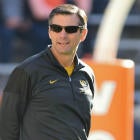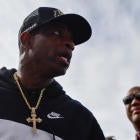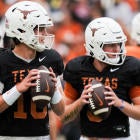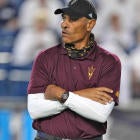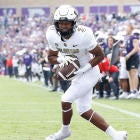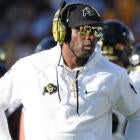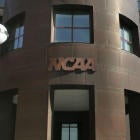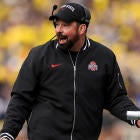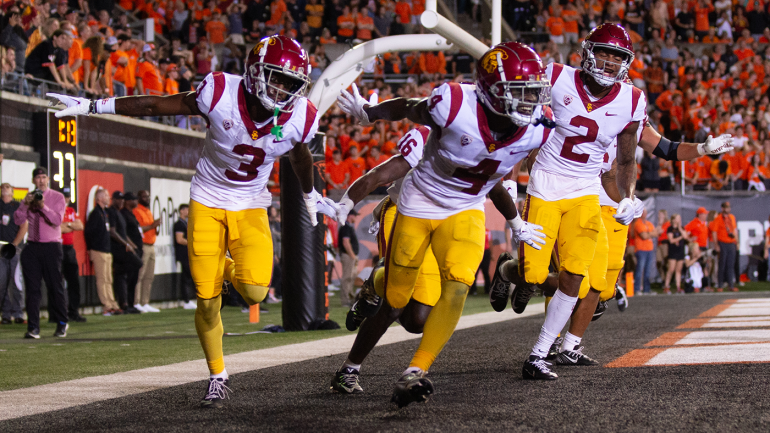
The greatest transfer class in history has not disappointed. It's not just the 20 players Lincoln Riley brought in to help renovate USC this season. It's what he did with them.
"Microwaved the roster that needed a ton of help," said Cooper Petagna, national recruiting analyst at 247Sports.
There are some qualifications for these labels. Greatest in history? Basically, yes. That history encompasses the modern transfer era, which is 18 months old. As for the speed of USC's turnaround, the Trojans are 9-1 less than a year after cratering at 4-8 amid both fan apathy and desperation.
"Microwaved" absolutely applies to a program that had grown stale.
The No. 7 Trojans are more than hot heading into Saturdays' rivalry game with No. 16 UCLA. Not only is a Pac-12 Championship Game berth on the line for USC, it may put itself in position for a College Football Playoff berth, the Pac-12's first in six years.
You know the main attractions, all transfers: Quarterback Caleb Williams has gone from his Washington, D.C. area home to the West Coast (with a one-year stop at Oklahoma) and become a Heisman Trophy contender. Running back Travis Dye (via Oregon) is No. 3 in Pac-12 rushing despite now being out with a season-ending injury. Linebacker Shane Lee (via Alabama) leads the Trojans in tackles. The top four receivers are all transfers, too. Most notable among them is leading pass catcher Jordan Addison (via Pittsburgh), who made waves leading the Panthers for the Trojans after emerging last season as the Biletnikoff Award winner.
It's clear Riley, the coach with the most transfers in 2022, also has done the best with them. The last USC coach to start 9-1 or better in his first season was John Robinson, 46 years ago.
USC is not alone
The importance of making transfers part of the game plan has been elevated since the portal turned four last month. The transactional nature of using transfers as a quick-fix turnaround crystalized in the last year or so.
Just check 247Sports transfer rankings from before the season. USC (20 transfers), Ole Miss (17) and LSU (16) were 1-2-3. They are a combined 25-5, all ranked in the top 14 of the CFP Rankings heading into Week 12. The Trojans and Tigers are realistic playoff hopefuls.
"You have to look at the circumstances when you come into any business or organization," said LSU coach Brian Kelly, who has become a turnaround artist himself this season. "What is the organizational health? The organizational health was such that it needed to be rebooted."
Petagna is an informed observer with extensive experience. The 247Sports analyst came to his current position from player personnel jobs at Oregon, Washington and Michigan. Informed is an understatement. How many guys anywhere have worked for Mario Cristobal, Chris Petersen and Jim Harbaugh?
"To me, that [ideal transfer] number would around 17," Petagna said. "That would be a fifth of your 85 [scholarships]. I wouldn't be surprised if that starts to become somewhat normal -- 10-15 players a year especially for these prominent programs."
All of it should come with a disclaimer in these nascent days of one-time transfers: Makeovers don't guarantee success. Among 247Sports top 12 in transfer rankings before the season were Miami (11 transfers), South Carolina (nine), Nebraska (15), Texas (seven) and Oklahoma (14). Combined records of those five: 25-25.
USC remains the shining transfer jewel of 2022. To date, the Trojans have improved a net six games from last year's disaster. The 4-8 record was their worst season in three decades.
Kelly is close behind having inherited an LSU roster filled with only 39 scholarship players going into January's Texas Bowl. His 16 transfers have helped the Tigers climb info playoff contention at No. 6 in the CFP Rankings. TCU went from a 5-7 messy divorce with Gary Patterson to a 10-0 record and No. 4 under coach Sonny Dykes, who has done it with 14 transfers himself.
"In my stage of life, I don't know how it gets any better," Dykes said.
No. 16 UCLA, 10th in those transfer rankings, brought in 13 new players. Lane Kiffin long ago named himself "King of the Portal;" he has Ole Miss ranked No. 14.
Is the transfer method sustainable?
They're not exactly making it up as they go along. But they are making it -- for now. The ability to spin gold out of football itinerants has become one of the main headlines of this season. Who knows where it's headed?
"If you would have asked me at the beginning of this season if this was sustainable, I probably would have said, 'No," Petagna admitted. "You ask me now, I think if you approach it the right way -- the roster has to be in balance -- yeah, for sure."
Now, where do we go from here? Is the plug-and-play philosophy sustainable -- not just at USC but everywhere?
"It's a putty situation," veteran ULM coach Terry Bowden said of the current state of the portal, "but I'm pretty sure nobody wants to build and live that way. They bring you in and you better win pretty quick. You better not be losing by your second year."
Riley has said from the beginning he wants to rely more on high school players in the future. (USC's 2023 class is ranked 13th by 247Sports with 20 commitments.) But he didn't wait to read the room before implementing his immediate quick fix.
"I don't know what a honeymoon looks like," Riley said before the season.
Maybe we should have seen this coming. When Baker Mayfield won the Heisman under Riley at Oklahoma in 2017, he was the first transfer since 1945 to claim the game's highest award without having to first make a pit stop at a junior college. Kyler Murray, a Texas A&M transfer, followed at OU a year later.
The journey to this place started agonizingly slow. Eleven years ago, Russell Wilson left NC State for Wisconsin as a graduate transfer when then-Wolfpack coach Tom O'Brien chafed at the quarterback playing baseball in the offseason. The portal opened in 2018, cutting coaches out of their abusive practice of "blocking" players from their preferred transfer destination. Simply put, grown adults didn't have to ask permission to change colleges.
By 2021, the one-time transfer rule became inevitable. The NCAA -- scared by the legal repercussions -- had to relent. They had begun granting transfer waivers so frequently that it seemed silly to restrict players at all.
Riley came along at the right time. USC was down and desperate. It pursued Riley not knowing the coach had always had a thing for the West Coast. USC changed its football profile, paying top dollar and giving Riley the keys to a long-neglected Ferrari.
The coach had a plan. He/we just didn't know how well it would be executed. Of the 20 transfers, 17 opened the season on the two-deep depth chart. Williams was one of two former five-star prospects. There were five four-stars, too. Except for the tight ends, at one point, all the skill position players were transfers.
Then USC itself transferred -- to the Big Ten in 2024.
We certainly have to start asking a different set of questions. Is the portal a philosophy, a sometimes-used tool or a blend of both?
"I can give you my philosophy, which is, I think it can be managed," Kelly said this week. "That is, you can top the tank off. Most of the tank has to be through player development, through freshmen. … Then you can bring a guy because they can assimilate to the culture you built."
But the reliance on transfers at USC, LSU, Ole Miss and TCU has suggested a rethinking of it all. Dykes lost perhaps his best running back, Zach Evans, to Ole Miss. Somewhere down the food chain, Bowden lost the talent he called his "best player," cornerback Josh Newton, to TCU.
It's either kill or be killed by the portal these days.
Concerns overblown?
Ten or so years ago, Bowden decided to create his own transfer splash at Division II North Alabama. Bobby Bowden's son had decided to break back into coaching after a lengthy career as an ABC analyst. At one point, all 11 of his offensive starters were transfers from FBS schools. The Lions eventually got to No. 1 rankings at a price.
"By the time we got to the playoffs, my receivers wouldn't block for each other," Bowden said. "One was getting more balls thrown to him."
With the one-time transfer exemption only 19 months old, evidence of locker room strife has yet to surface on a national level. Maybe that's because we're writing mainly about the success stories. But you know there are issue out there. Roster management is tough enough for coaches without itinerant players flowing in and out of the program.
"What they've been able to do is really, really difficult -- and not easy to replicate," said Pro Football Focus college analyst Anthony Treash regarding USC. "We can't measure the culture aspect. Culture is huge. Getting all these guys together and saying, 'Hey, these aren't guys who have spent three years together.'"
John Canzano reported this month on the supposed NIL benefit demands from QB JT Daniels, now on his third school at West Virginia: a personal chef, a four-bedroom rental house and a six-figure endorsement deal.
"Chemistry is still the one thing that can really upset a locker room," Kelly said. "Just because they're great players doesn't make them great teammates. That's why they call it a portal. They beam you up on campus. I don't know if anybody wants to develop their program strictly through the portal."
Except that's what Riley essentially did. In the span of about two months, he brought in about 40 new players, including the high school recruiting class. Kelly didn't have a choice given his roster attrition.
Add in the implications/complications of NIL, and the game continues to change before our eyes. Schools are flat-out assembling what amounts to "war chests" to be able to "offer" NIL money to players. Programs aren't allowed to directly make NIL offers, but that's what it has essentially become as one Power Five basketball coach described the typical opening line from recruits: "How much can I get?"
"Are you going to use the NIL resources on the front end in terms of talent acquisition, or are you going to pay the players on your roster or use it in the transfer portal as well?" Petagna asked rhetorically.
"The biggest joke in the world: You can't give a guy NIL because of performance or recruiting. But when it comes down to it, that's the only two reasons you do give it," Bowden explained.
Williams' NIL opportunities have been well-chronicled but don't seem out of line compared to other top quarterbacks. Riley shot down accusations of tampering by Pittsburgh coach Pat Narduzzi during his pursuit of Addison.
"Look at USC, what they were able to do, instant credibility," Petagna said. "These [analysts] will tell you the most dangerous program is USC because guys want to be there."
Will USC bring it home?
Saturday, then, might as well be the Pac-12's Super Bowl. Not only for this season but for the future. The league hasn't been this good, this deep in more than half a decade. USC is the conference's last, best hope to make the CFP ... as it prepares alongside UCLA to leave for the Big Ten in two years.
The best win for the Pac-12 long-term will be achieved in Eugene, Oregon. Even though Oregon and Utah each have two losses, they'll form the backbone of the realigned Pac-12 in a couple years. The league, however it goes forward, needs them both to be good on the field.
Kelly is using a formula that Nick Saban perfected when he arrived at LSU in 2000: put up a recruiting fence around the state of Louisiana and don't let the talent escape. Kelly took it a step further, dipping into the portal for native Louisianans from other programs.
LSU's coach helped remake his secondary with three transfers from Louisiana. Joe Foucha, a New Orleans native, brought 33 career starts from Arkansas. His roommate, Greg Brooks from Harvey, was a three-year starter for Razorbacks. Oklahoma State transfer safety Jarrick Bernard-Converse of Shreveport has started seven games this season.
As with USC, bringing in the talent was not enough; the LSU transfer class needed to click. Jayden Daniels (via Arizona State) has been the point man having a career year at quarterback. Noah Cain (via Penn State) has 216 yards rushing and four touchdowns. Mekhi Wingo (via Missouri) leads the interior defensive linemen in tackles.
There is now at least some order to the process. As Year 2 of the portal begins next month, two transfer "windows" have been created. Players will be allowed to transfer during two periods throughout the academic year. For football, it is 45 days beginning a day after CFP Selection Sunday. That selection date floats between the first or second week Sunday in December.
There will also be a window from May 1-15. That aligns with the end of spring practice (for most schools). Still, there is expected to be a rush of talent into the portal after spring practice for those two weeks amid injuries, position battles and just plain pouting cause flux with depth charts.
That at least funnels the flow of talent into specific time periods for coaches, who were caused so much frustration by the year-long open portal. In the first year of the one-time transfer exemption, approximately 6,600 players entered the portal across all three divisions. That was roughly an average of 10 portal entries per school.
For at least a season, the likes of Riley, Kelly, Kiffin and Dykes completely figured out the system. At the same time, they are raising the bar of expectations. They've all sustained or turned around programs within two years. Every athletic director must be thinking: Why can't I do that here?
Coach after coach for years has stressed the dangers of taking transfers. There was always "baggage" regarding a transfer, a negative "reason" that player was leaving one school for another. That's all changed in the portal era because it is open to everyone -- those with grade problems, those who lost a position battle, those with simple wanderlust.
"There's a lot of people that still have this thought process that, to me, is a little bit archaic," Bowden said. "'There's a reason this guy is in the transfer portal.' … Now they see an immediate path to the field. It's not a character issue, or it's not a specific flaw."
In the case of Williams, it was simply following his coach from Oklahoma. Except it wasn't just that. Williams and his family were reportedly upset at first with Riley for leaving after the quarterback's first season. Williams looked at his options. Shortly before the enrollment deadline approached at USC, he ultimately decided to come along for the ride.
"The deciding factor for me, actually, was how familiar I was with all the people coming here," Williams told CBS Sports before the season. "Coaching staff, nutritionists, everybody knows Coach Riley. I was very familiar with their families. Very close. I didn't want to feel like a freshman going to a new place, having to learn a new offense."
As time has gone on, programs have developed persons or even entire departments to monitor the portal. They can afford to skim the cream off the top enhancing the possibility of -- just not guaranteeing -- an upside.
Wisconsin interim coach Jim Leonhard didn't exactly break news last week when he said teams were poaching his players as the Badgers transition to a new head coach. Welcome to the 21st century. Poaching and enticements or whatever are against NCAA rules, but try to find an example of a violation ever being prosecuted.
Better yet, embrace the portal. For coaches like Leonhard just realizing the possibilities, it is both a tool and a curse. But it isn't going away.
"When I give a speech on pregame, it ain't the same eyes that I saw before," Bowden said. "There's two games left. I guarantee you people are already talking to people."













